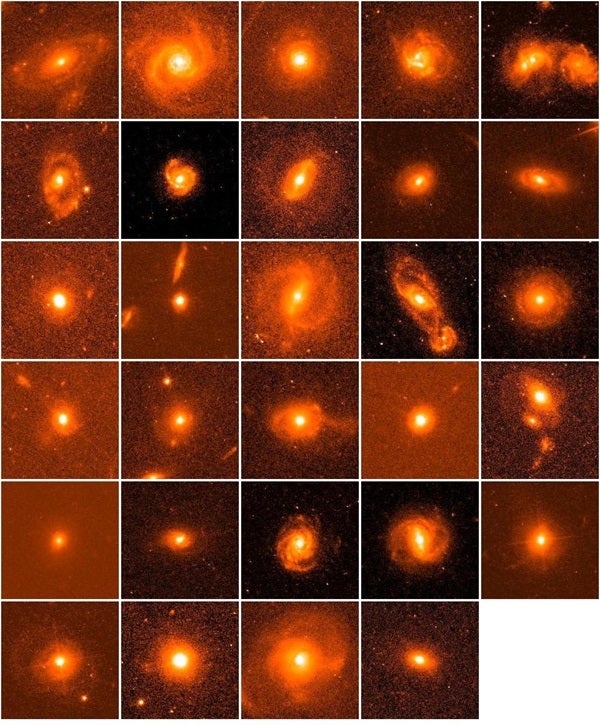Astronomers believe the big galaxies we see nearby were built up by mergers with many smaller systems when the universe was young. On June 2, at the American Astronomical Society meeting in St. Louis, a group led by Michael Brotherton at the University of Wyoming released new Hubble Space Telescope images that show the process in detail.
“The images started coming in, and we were blown away,” Brotherton says.
Long before galaxies merge, they interact gravitationally. This distorts their appearances and compresses their gas clouds, igniting intense pulses of star formation astronomers call starbursts. The most massive stars formed in starbursts blow up as supernovae in relatively short time. The dust these stellar explosions produce tend to shroud the infant starbursts from astronomers’ prying eyes. Then, another event occurs that completely outshines the galaxy.
During the last decade, astronomers have established that just about every galaxy harbors a supermassive black hole at its center. Astronomers believe that galactic mergers so shake up young galaxies that their central black holes experience the equivalent of a smorgasbord. Gas and stars stirred up in the interaction feed the black holes, which eventually merge themselves. The fueling and growth of black holes powers a variety of phenomena in young galaxies. The most luminous manifestation of this activity is a quasar, which is so bright the underlying galaxy becomes all but invisible.
So, mergers in massive galaxies first trigger starbursts, which gradually fade out, and then fuel a central black hole, which turns on a quasar. The quasar blows away the dust obscuring the starburst, but it also effectively blinds astronomers to detailed study of the underlying galaxy.
Brotherton reasoned that there should be transition galaxies in which the fading starburst and the quasar can be seen at the same time. In the late 1990s, he found a candidate for one of these objects. Its spectral signature indicated the presence of both a quasar and a starburst that was already 400 million years old. Brotherton dubbed the object a “post-starburst quasar” and imaged it with the Hubble Space Telescope. The images revealed an object that was clearly the result of galaxy mergers.
To find more of these rare galaxies, Brotherton and his colleagues turned to the Sloan Digital Sky Survey, the largest catalog of quasar and galaxy spectra in existence. They found 600 objects with the characteristic signatures of post-starburst quasars.
Using the Hubble Space Telescope and its Advanced Camera for Surveys, the team observed the galaxies in their sample that showed the strongest stellar component. The galaxies all are located 3.5 billion light-years away, but Hubble can resolve details just a few thousand light-years across, which enables astronomers to see structural details. Hubble imaged 29 post-starburst quasars using a red-light filter that emphasized starlight and suppressed the quasar’s glare.
The galaxies are an untidy lot. “We see not only merger remnants as in the prototype of the class, but also post-starburst quasars with interacting companion galaxies, double nuclei, starbursting rings, and all sorts of messy structures,” Brotherton says.
The Hubble images also provide a look at different phases of the process. “These images provide us tremendous insight into the complexity of galaxy evolution,” said team member Rajib Ganguly at the University of Wyoming. “We see nuclear activity and post-starbursts simultaneously in systems from pre-merger to post-merger and in between.”
The astronomers hope to characterize each galaxy’s physical properties, such as the masses and ages of the post-starbursts and the masses and fueling rates of the central black holes. Brotherton says team member Gabriella Canalizo has already obtained high-quality spectra from the Keck Observatory in Hawaii for this purpose.
“Key aspects of galaxy evolution do seem to be driven by mergers and interactions, at least in the most massive systems,” Brotherton says. “And the picture is a lot more complicated than anyone thought.”










